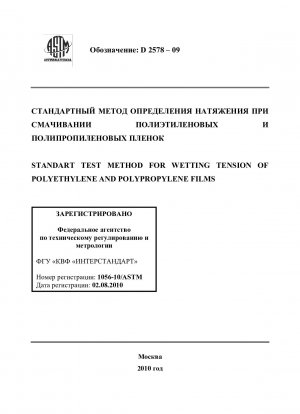ASTM D2578-09
Standard Test Method for Wetting Tension of Polyethylene and Polypropylene Films
- Standard No.
- ASTM D2578-09
- Release Date
- 2009
- Published By
- American Society for Testing and Materials (ASTM)
- Status
- Replace By
- ASTM D2578-17
- Latest
- ASTM D2578-23
- Scope
When a drop of liquid rests on the surface of a solid, and a gas is in contact with both, the forces acting at the interfaces must balance. These forces can be represented by surface energies acting in the direction of the surfaces and it follows that:

where: θ = angle of contact of the edge of the drop with the solid surface, γGL = surface energy of the gas - liquid interface, γGS = surface energy of the gas - solid interface, and γSL = surface energy of the solid - liquid interface. The right side of the above equation (the difference between the surface energies of the gas - solid and solid - liquid interfaces) is defined as the wetting tension of the solid surface. It is not a fundamental property of the surface but depends on interaction between the solid and a particular environment.
When the gas is air saturated with vapors of the liquid, γGL will be the surface tension of the liquid. If the angle of contact is 0° the liquid is said to just wet the surface of the solid, and in this particular case (since cos θ = 1) the wetting tension of the solid will be equal to the surface tension of the liquid.
The ability of polyethylene and polypropylene films to retain inks, coatings, adhesives, etc., is primarily dependent upon the character of their surfaces, and can be improved by one of several surface-treating techniques. These same treating techniques have been found to increase the wetting tension of a polyethylene or a polypropylene film surface in contact with mixtures of formamide and ethyl Cellosolve in the presence of air. It is therefore possible to relate the wetting tension of a polyethylene or a polypropylene film surface to its ability to accept and retain inks, coatings, adhesives, etc. The measured wetting tension of a specific film surface can only be related to acceptable ink, coating, or adhesive retention through experience. Wetting tension in itself is not a completely acceptable measure of ink, coating, or adhesive adhesion.
Note 38212;A wetting tension of 35 dynes/cm or higher has been generally found to reveal a degree of treatment normally regarded as acceptable for tubular film made from Type 1 polyethylene and intended for commercial flexographic printing. It is, however, possible that some other level of wetting tension may be required to indicate the acceptability of polyethylene films made by other processes, or from other types of polyethylene, or intended for other uses.
At the present date, insufficient experience has been gained to state a generally acceptable level of wetting tension for polypropylene films for commercial flexographic printing.
1.1 This test method covers the measurement of the wetting tension of a polyethylene or polypropylene film surface in contact with drops of specific test solutions in the presence of air.
1.2 The valu......
ASTM D2578-09 Referenced Document
- ASTM D618 Standard Practice for Conditioning Plastics for Testing
- ISO 8296 Plastics - Film and sheeting - Determination of wetting tension
ASTM D2578-09 history
- 2023 ASTM D2578-23 Standard Test Method for Wetting Tension of Polyethylene and Polypropylene Films
- 2017 ASTM D2578-17 Standard Test Method for Wetting Tension of Polyethylene and Polypropylene Films
- 2009 ASTM D2578-09 Standard Test Method for Wetting Tension of Polyethylene and Polypropylene Films
- 2008 ASTM D2578-08 Standard Test Method for Wetting Tension of Polyethylene and Polypropylene Films
- 2004 ASTM D2578-04a Standard Test Method for Wetting Tension of Polyethylene and Polypropylene Films
- 2004 ASTM D2578-04 Standard Test Method for Wetting Tension of Polyethylene and Polypropylene Films
- 1999 ASTM D2578-99a Standard Test Method for Wetting Tension of Polyethylene and Polypropylene Films
